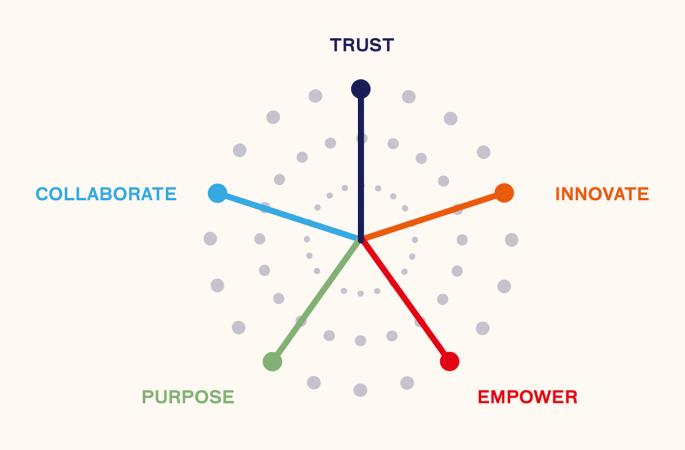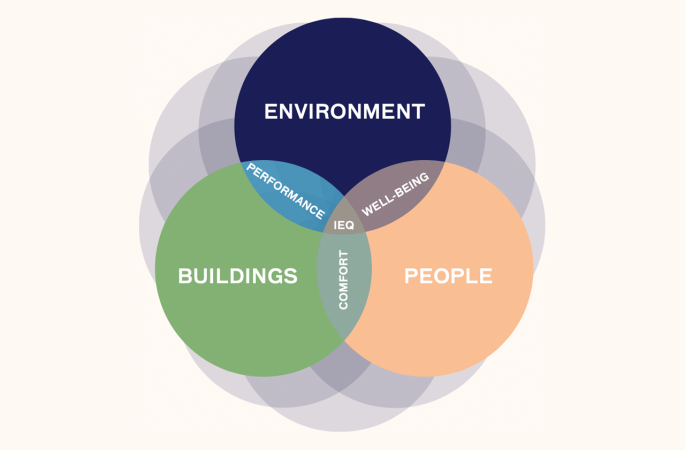
The Future of Cities in the Gig Economy
It’s a simple formula: People + buildings + environment. That straightforward relationship has driven the evolution of human existence for hundreds of thousands of years. But today, the formula is shifting. The Gig Economy, with its independent contractors, small-scale companies, and rapidly evolving relationships, is forcing an algorithmic shift in the way actual cities evolve.
For Saint-Gobain, that combination of different ways of working, new players and the evolution of urban environments happens in a very unique context that takes into account sustainable development, new and innovative building materials, and how both impact the well-being and comfort of people around the world. In fact, those activities are more than a business model — it’s the company’s overriding purpose. The 354-year old company, founded by Louis XIV, is one of the world’s largest building materials company and spends much of its time focused on how to deliver comfort and well-being to people in every corner of the world. But the trend toward urbanization and the growth of megacities means that we can and must grapple with how we build these complex urban environments, how people interact with each other and the buildings and, most importantly, how those interactions improve the experience of all involved.
In the Saint-Gobain gigonometry equation, the math is a little bit different than for the typical building company. Most people who manufacture and construct buildings are focused on the actual experience of construction, in that complex (and changing) process of designing and constructing the building. Saint-Gobain takes that process one step further. When all those design and construction experts leave, who stays to understand how the behaviors of the people in these new spaces changes and evolves over time as they get used to these spaces, as their activities shift and morph, and as their needs evolve? Saint-Gobain realized that if they stay when traditional builders leave, their role shifts in that relationship to occupants from a temporary resource and more toward a long- term partner. They effectively shift the timeline of the experience and change the equation.
But to fully advance that shift, Saint-Gobain has started to look at the concept of enterprise innovation, where every employee, partner and contractor is tapped for their expertise and their ability to not simply have a good idea, but implement those ideas in ways that add value to the company, customer, end-user and, ultimately, to society. It’s a pretty bold idea spearheaded by Saint-Gobain’s Chief Innovation Officer, Tom Kinisky. Kinisky, who started his career in Research and Development, shifted to business management and ran a wide range of businesses for the company over the course of his 30-plus year career. In that time, he came to understand that innovation is not simply the purview of Research and Development, but really more about how we apply unique points of view and areas of expertise to solve real world problems. The gigonometry in this case is more around the interaction of diverse backgrounds and experiences of experts and implementing a rigorous innovation discipline across the company, all in the service of solving real practical business problems.
Parker’s Circle of Fifths


From Jazz Improvisation to Enterprise Innovation
Recently, Kinisky partnered with author and entrepreneur Josh Linkner on a corporate event for Saint-Gobain, where the two used the analogy of jazz improvisation to explain the nature of Enterprise Innovation. Linkner, the founder and CEO of five tech companies, which sold for a combined value of over $200 million, is also the author of four books, two New York Times Bestsellers: Disciplined Dreaming: A Proven System to Drive Breakthrough Creativity, and The Road to Reinvention: How to Drive Disruption and Accelerate Transformation, as well as his latest book, Hacking Innovation. Keying off of the musical concept of the circle of fifths and the way John Coltrane reimagined them in his seminal Jazz wheel, the two men brought very different career experiences to the theme that connects strongly to the concept of gigonometry.
Both men acknowledge that what John Coltrane did in his composition Giant Steps was to find a way to reimagine a traditional idea, in this case the circle of fifths, originally explained by Greek philosopher and mathematician Pythagoras. But for Coltrane, the idea was to stretch that methodology, to push it to its farthest reaches to create music that bent, but never broke the logical and mathematical constructs of the notes. Linkner compared this breakthrough to entrepreneurs who marry together very different markets to create new value, while Kinisky focused on how to apply those same concepts to a large, complex corporate culture. Using five key attributes, Trust, Empowerment, Collaboration, Innovation and Purpose, Kinisky showed that any individual, with the right context, can find ways to innovate. Like Parker, he explained that by looking at a discipline differently, making unique connections and sharing the model with bandmates or colleagues, a leader can lay out a blueprint for improvisation, new ways of thinking and, potentially, breakthroughs that can drive real, sustained innovation.
That math and the need to more effectively engage the entire workforce has been demonstrated in the company’s corporate headquarters in North America, which opened in 2015. The Malvern, Pennsylvania location was designed around the company’s philosophy of “MultiComfort,” which takes into account building occupants’ overall feelings of comfort and well-being in a space. The building itself employed a wide range of Saint-Gobain products and technologies to improve acoustics, air quality, light management, collaboration and concentration. In order to evaluate the impact and efficacy of that Multi Comfort design elements in the new headquarters, Saint-Gobain partnered with a group of subject matter experts led by Dr. Ihab Elzeyadi, Director of the University of Oregon’s High Performance Environments (HiPE) Lab, to conduct an extensive four- phase comparative analysis of Indoor Environmental Quality (IEQ). In the first phase of the study, a research team inspected the existing unoccupied Malvern facility prior to its adaptive renovation and reuse. In the second phase, the team examined the former Saint-Gobain headquarters in Valley Forge, Pennsylvania, to establish a benchmark for the performance of the new headquarters. In phase three, the team analyzed the new headquarters following envelope upgrades and interior design retrofits, but prior to occupancy. Finally, the fourth phase of the study assessed the newly completed Malvern headquarters post-occupancy.
IEQ ToolboxTM Framework

The above graphic shows how this complex geometry of concepts delivered a new, more dynamic space. By focusing on a wide range of factors that truly impact how people feel, areas like air quality, amount of daylight, acoustics, thermal comfort and health and well-being, the company saw employees’ perceptions of productivity and happiness at work dramatically improve. These are real results that go straight to a company’s bottom line as a healthier, happier workforce leads to a more profitable company. Overall perceived productivity also increased by 38.9 percent in the Malvern facility, indicating that employees feel like their new Multi Comfort work environment contributes to their success in the workplace. In some cases, increases in productivity have been quite plainly evident. For example, during the first three weeks of occupancy, the productivity of Saint-Gobain’s Call Center increased by 140 percent, with no changes in hours or staff.
Looking Beyond Statistics
So why does that kind of math matter for today’s cities? Simple. The very definition of work is changing. The gig economy is causing massive changes in who works where, for how long and in many different ways.
That straightforward relationship between people, buildings and environment has driven the evolution of human existence for hundreds of thousands of years. But today, the formula is shifting
Consider this: According to Forbes, about a third of U.S. workers participate in the gig economy. That’s 57 million people. Staffing Industry Analysts (SIA), a global advisor on staffing and workforce solutions, publishes a yearly report on the gig economy and estimates the total global gig economy spending hit $4.5 trillion in 2018.
But numbers never really tell the whole story. We have to look beyond statistics to understand the people and behaviors shaping this massive shift.
Right now, in virtually every corner of the world, there are thousands of teams at work on highly technical issues in fields as far-ranging as filmmaking, medical research, aerospace, and construction. Those fully functioning teams have members living, working, and collaborating from homes, offices, cafes, and carparks in Europe and North America, across Asia and the Middle East, India, Africa, and even Antarctica. They work “together” via file sharing, live, virtual conferencing, teleconferences, chats, and texts. And when they succeed, those teams disband, returning to their far-flung geographies to live, work, play, learn and collaborate with a different collection of diverse experts, week-by-week, month-by-month, and year-by-year.
How then, can we expect our cities to evolve in traditional ways as work and life itself are shifting and changing in form and function, and at rates not seen since the Renaissance, the Age of Enlightenment, and the Industrial Revolution?
The short answer is: we can’t.
Cities can, must, and are changing and often for the better. Our buildings are becoming smarter, able to adapt to our changing needs not just year-to-year, but in some cases, minute by minute. Our classrooms are becoming more fluid as students are taught to explore their surrounding world as an extension of their classroom curricula.
Our hospitals are transforming from places that treat disease and injury into state-of-the- art wellness centers designed, built, and run in the service of the human being, not merely to address the maladies of their bodies.
And this is where the math comes in.
The inter-relational geometry of people, places, and their evolving uses must be understood at deeper and broader levels if we want to take full advantage of this new way of working. First, people’s behaviors are changing. In this emerging gig economy, the labor market is moving toward short- term contracts or freelance work as opposed to permanent jobs. That faster-moving, constantly shifting labor market is already something with which you and I are deeply familiar even if we don’t realize it.
Disagree?
Well, how about this? Fifteen or twenty years ago, coffee shops were places where people drank a cup of coffee, talked to the person next to them, ate a pastry, and left. It was an experience that lasted somewhere between thirty and sixty minutes. Today, the entire purpose of a coffee house has changed. Now, they are virtual offices for thousands upon thousands of Gig workers, who access information and colleagues in cities and towns scattered across the globe, speaking languages that would rarely be heard side-by-side. People spend hours working, talking, and collaborating. We accept this behavior as fact, but in our every-day lives, most of us ignore the implications of such a fundamental change. Commerce is taking place in those cafes. You may be walking past a twenty-something millionaire, an inventor of a digitally printed manufacturing technology, or a small business owner carving out a previously untapped market. In fact, in today’s information age, an innovative data- miner could create an app that charts the direct impact coffee-shop gig economy workers have on the Gross National Product of Israel, the United States, France, or Singapore.
But here is where it gets even stranger. You probably didn’t notice that the design of those coffee shops has changed quite a bit in those years as well. Look around. The acoustics of these spaces have improved. Their furniture is more comfortable. Their layouts afford greater privacy and intimacy, and virtually every corner of that space has access to sunlight and the outside world.
These changes are not accidental. Architects, building scientists, designers, and business people are planning and adapting scores of different spaces, often using people actively participating in this gig economy. So, we’ve changed a variable. When is a coffee shop no longer a coffee shop? When it becomes a business incubator, a collaborative space, an office and conference center. The geometry of coffee shops is fundamentally different because of the gig economy. Its purpose has morphed and expanded. Get it? More facets, more uses, more needs, more opportunities.
Now, let’s shift to office buildings. These fundamental places of work, where generations of people have labored in the service of a corporation, are changing because of the gig economy. Four walls and a roof just won’t do it. The math has to change. People are much more likely to treat permanent positions at companies as full-time gig opportunities, jobs that they expect to change, and evolve in a much nimbler way than many traditional corporate workers may expect. Contractors, temp workers, agencies, and consultants all swirl and mingle in these spaces. Add to that the fact that Gig workers often are motivated by a greater sense of purpose, the idea that the fruits of their labors must have a positive and vital impact on the world, whether that is through sustainable practices, green technologies, a safer world or a more positive society, and you can see the geometry of offices shift even more. These new office buildings must be an expression of the company’s brand — of its value to the world, and its value to those Gig team members who have the choice to work with, for, and among so many other businesses.
Because let’s face it. The power is shifting. The choice, the variety, and the experience of these gig economy workers will only increase. The breadth of their work experiences across multiple companies, industries, work styles, cultures, and problems mean that the workers are much more likely to see patterns of best practices. They are more attuned to finding better ways of working or assembling new and unique solutions to a host of new or emerging issues in such disparate areas as manufacturing, digital technologies, sustainability solutions, financial services, and hospitality. What they lack in traditional corporate safety nets like pensions, 401(k) matches, and other benefits often are offset by flexibility, an ability to hold multiple jobs, and for some, the long-term prospect of venture capital investment.
These thinkers and doers often are looking to create environments where ideas thrive, where collaboration happens in a more fluid way and where the best and brightest want to spend a considerable amount of time.
It’s a world where an improvement in the quality of space that helps generate a worldclass idea is worth its weight in gold
The Impact of the VC Community
In fact, there are two very different ways to look at how the VC community impacts the gigonometry of cities. The first is the investment cycle and where and how VCs play in that sphere, where investments in gig-based businesses work and where they don’t. The second is really around how VC organizations can help fund environments where gig economy businesses can meet, collaborate, and expand and/or link their models.
From an investment side, it’s a volatile world. While the vast majority of participants in the gig economy are freelancing individuals, who enjoy and are committed to the personal flexibility it offers, the number of entrepreneurs who are looking to create larger companies is increasing dramatically. These thinkers and doers often are looking to create environments where ideas thrive, where collaboration happens in a more fluid way and where the best and brightest want to spend a considerable amount of time.
It’s a world where an improvement in the quality of space that helps generate a world- class idea is worth its weight in gold.
One only has to take a quick peek at WeWork’s IPO and that beleaguered company’s efforts to provide sustainable, profitable growth projections to a market hungry for but critical of this new business construct. Bhanu Ramenani, in his article, “Is the gig economy crushing the ‘American Dream,’” offers a cautionary take on the way gig economy platforms, such as Airbnb and VRBO, Uber and Lyft undercut the traditional companies, employee benefits, and the social safety net. So the real question in the gigonometry of business is how both individuals and investors can benefit from what is inarguably a long term trend. Ramenani suggests that government regulation that protects workers’ pay and benefits, coupled with a focus on shareholder value, are crucial. I would argue that there is a third factor that drives the economic side of the gigonometry equation – a unifying sense of purpose. Shareholder value, protection of workers’ rights, and an integrated purpose that links those two activities sets up a wholly unique paradigm as illustrated on the previous page.
People spend hours working, talking, and collaborating. We accept this behavior as fact, but in our every-day lives, most of us ignore the implications of such a fundamental change
Purpose Beyond Profit
Picture a company five to ten years from now dedicated making the world a better place. It could be a tech company, a manufacturing company, a pharmaceutical company or a consumer company. The industry isn’t that important. What is important is that the employees, contractors, suppliers, and customers understand the impact that company has on the world and they share in the vision that the company will in some unique way make the world a better place. In other words, it has a purpose beyond profit. These people have an aligned passion and sense of purpose that taps into their deeper intellectual and emotional cores. Think: a system that removes plastics from the ocean, a new medical treatment that replaces chemotherapy with immunotherapy or a methodology for helping all people on the planet reduce their carbon footprint. These larger purposes, coupled with the gig economy’s access to broad ranges of thinking and experience, in turn, married to that idea of self-selection of a common purpose, unlocks a level of Enterprise Innovation that could shift the nature of innovation itself. This model encourages movement, diversity of thought, experience and background, and takes into account that such teams need not be in the same neighborhood, city or continent. Instead, each urban center develops spaces that encourage and enable connectivity, collaboration and commitment in ways that are unique to their cultures and geographies, separate but interconnected.
A city with its concentrations of people, industry, resources, and infrastructure can develop in a haphazard or planned way. But when the “business” of urban development takes into account the shifting nature of work and purpose the nature of urban planning shifts as well. Instead of simply addressing the constant grind of urban growth, planners think more broadly than economic growth, public transportation and adequate housing. They start to see their missions integrating with those other purpose, driven organizations to collaborate differently, to marry economic growth with environmental stewardship in the service of livability and comfort for all residents.
So what does that have to do with the gig economy? Quite a lot, actually. Gig economies are in constant flux. The ebb and flow of people, teams, gigs, mega-gigs, investment cycles, and evolution of behaviors itself are spawning urban ecosystems custom-designed to evolve with and in response to these factors. But here’s the thing. Most of us don’t see it. We are too close to the details, too wrapped up in the day-to-day activity of it all to see the larger picture. We hear about the gig revolution, but we can’t see it, and the reason why is simple. We are inside it. It’s only when you step back far enough to see those patterns, that the whole is revealed because it is not a simple, easily defined revolution. Instead, it is an evolution revolution. A thousand tiny turns that together drive the more significant revolution.

Evolution Revolution: Real-world Examples
Here are a few examples that show how this is happening. Do you know you can take the shoosh out of a library? There are acoustic systems that allow us to control sound and overall acoustics in space so that a librarian never has to shoosh a person again. But what does that simple solution enable? Well, it allows a study group (run by a gig economy tutor) to work together ten meters away from a community meeting (managed by a part-time community organizer), which is itself 20 meters away from someone else studying a complex text on how to become an entrepreneur. Now, that library is a much more dynamic space. Those three activities create a new gigonometric equation that redefines a library.
The same holds true for hospitals that can shift their function from injury and disease management to wellness and recovery or with reconfigurable office spaces that can go from open office to private or any combination in between. The combination of contract employees, freelance workers, or even full-time employees who also have a “side hustle,” all feed into this rethinking of the spaces in which we live, work, learn, heal and play. The fact is, the more dynamic these gig-based activities become, the more likely our urban spaces will evolve to shift, change, and adapt in real-time. And here is where it gets fascinating. The nature of venture capital investment will likely change in similarly dynamic ways. It almost has to. The gigonometry demands it. Investment in gig-based companies like Uber, Airbnb, or Design Pickle will continue, even if they launch fewer IPOs and more companies stay private. But at the same time, there is another whole world of companies dedicated to supporting the design, management, and evolution of the actual spaces, and that world is just starting to heat up. And when those two investment worlds connect, the landscape for our cities will morph at an even more rapid rate.
A great example of that evolution revolution exists just a stone’s throw from MIT and Harvard at Greentown Labs, which bills itself as the largest cleantech incubator in the United States. Located in Somerville, Massachusetts, it’s an organization that clearly has taken to heart the concept that the space you operate in reflects your brand. Their new, 53,000-square-foot expansion, which opened in 2018, is a dynamic stage for some of the most innovative green technologies of the last few years in areas like energy generation, energy distribution, and storage, transportation, building technologies, agriculture, and chemicals. In fact, since their inception, they’ve supported more than 170 startups, with more than 86% of them still operating today. Since its inception, Greentown Labs has raised more than $415 million in funding for the companies it supports.
So what is on the horizon for these cities of the future and the gig economy participants who will inhabit them? A more livable environment. More dynamic and changing spaces. A workforce with broader, more diverse people who, in turn, have more extensive and more varied experience across multiple industries, cultures, and technologies. Remember, these cities though physical, are now connected across vast distances via real-time, instantaneous technologies. Video conferencing, immersive collaborative platforms, and access to talent in any corner of the planet mean knowledge and experience can be tapped in ways impossible just a few years ago.
That gigonometry is only now being investigated and is not well understood. The implications, both good and bad, are leading us to an exciting place. We are raising children who will work on problems created by technologies that have not yet been invented. Those same children will work in ways we can hardly imagine with people in places many of them have never heard of, let alone experienced physically. These continually changing, dynamic urban environments will generate new problems to solve and new opportunities for investment, but also filled with risk. Understanding that evolution revolution, finding ways to see emerging patterns, and responsibly investing in the gig economy, will require more than money. It will require forethought, respect for all participants, and a commitment to behave responsibly for the planet and all who live here.
When the “business” of urban development takes into account the shifting nature of work and purpose the nature of urban planning shifts as well
